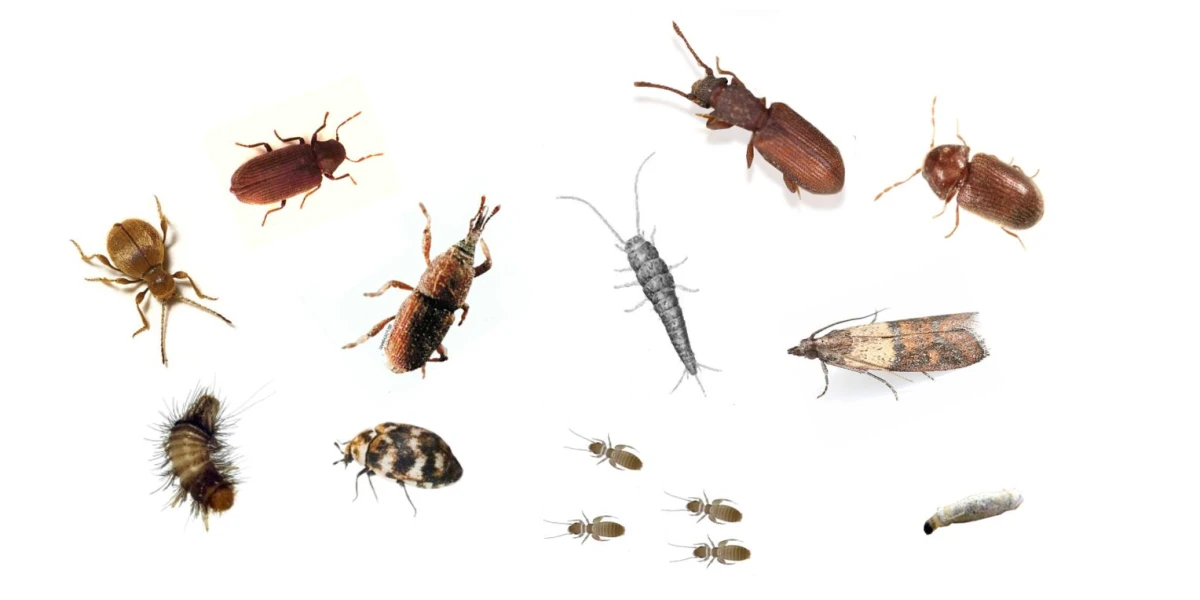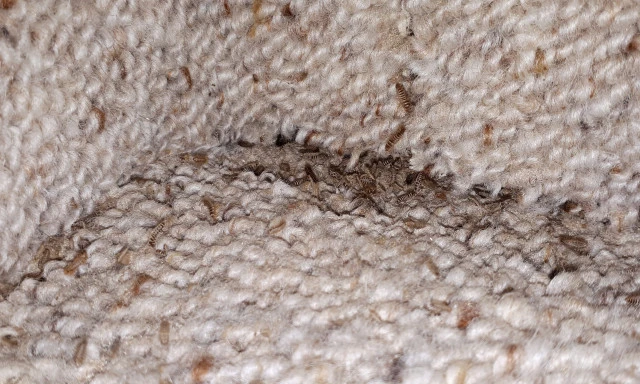SPI
Pests that eat, damage or contaminate things in your home are often called stored product pests. Most are insects and are called stored product insect (SPI) pests. These can include beetle, moths, mites, weevils, silverfish, booklice and others. They may eat damage and infest foods, furs, carpets, woollens, wood, paper, and other, usually natural, products. You will find a list of common stored product pests here.
Warehouse and commercial premises that store these sorts of products can develop very large infestations if the pests are not excluded or controlled effectively when they gain access. Homes too can get infestations; sometimes the pests can get into the home from neighbouring places or they can come in already infesting the products.
It is very often the larvae of the pests that do the damage e.g. carpet beetle larvae (woolly bear caterpillars), pantry moth larvae, woodworm.
Here is some advice on how to get rid of these pests.
Pests in Stored Food/Pantries
- Clean and Dispose – Check and dispose of all infested food.
Remove all the food and food utensils from the pantry.
Clean down all shelves by vacuuming or sweeping up all spilled dry food. Wash down all surfaces with detergent and water.
Let the surfaces dry completely. - Spray – Spray all surfaces with a light coat of NO Bugs Super or NO Spiders Total Protection. Pay particular attention to cracks and joins where spilled food may accumulate.
Let the surfaces dry completely.
Note: For booklice, NO Spiders Total Protection is the preferred option. - Replace and Keep Dry – Once the surfaces are fully dry put the foodstuffs back in the pantry sealed in airtight containers.
Keep all dried food and paper/cardboard packaging dry by ensuring good ventilation and heating. A dehumidifier can be useful in keeping the area dry.
Pests of Fibres/Carpet
- Spray – If you are able to lift the edges of the carpet (~30 cm); vacuum under the edge then spray the floor below and the underside of the carpet with NO Bugs Super. Put the carpet back down and lightly spray the upper surface in a band about a metre wide around the edge and affected areas.
If the edge of the carpet cannot easily be lifted then spray the upper surface relatively heavily using NO Spiders Total Protection. [NO Spiders Total Protection will move through the carpet to the underside more easily than NO Bugs Super.] Fumigate/Bomb – After spraying use NO Bugs Super Bug Bombs or NO Bugs Super Fumigator to quickly knock down adult beetles and moths and treat areas that may not have been sprayed.
NO Bugs Bug Bombs contain the same active ingredients as NO Spiders Total Solution and similar to NO Bugs Super. It will enhance the effectiveness of the targeted spray treatment.
Consider woollen items and other food for fibre damaging pest in roof voids, NO Bugs Bug Bombs are an ideal way to treat roof voids and other voids where insects may be living.Vacuum – After treatment, vacuum thoroughly to remove eggs, dead beetles, moths and larvae.
Dispose of the vacuum bag immediately afterwards by sealing in a plastic bag and placing in the rubbish.
Wood Boring Insect Pests
- Protect – The best option is always to protect the wood directly by treating it with long-lasting NO Borer Total Wood Protection fluid.
Treat any bare wood with NO Borer Total Wood Protection. NO Borer Total Wood Protection concentrate and ready to use will penetrate deep into the timber and in normal circumstances protect the wood for many years. Small areas where the solvent cannot be used can be treated with NO Borer Total Wood Protection ready to use trigger spray.
Inject - Inject flight holes in painted, varnished or polished timbers with NO Borer Spray Injector. The aerosol forces insecticide into the labyrinth created by the borer larva, killing any larva in the labyrinth or nearby. It also prevents adult beetles from laying eggs in the flight hole. Fumigate –Use NO Bugs Super Bug Bombs or NO Bugs Super Fumigator fumigators between Oct-Mar to quickly knock down adult beetles before they mate and re-infest wood.
Fumigation is often the only option for treating homes and buildings where all the timbers cannot be easily accessed.Ventilate/Dry - Borer prefer timber that has some moisture in it. Ensure that your sub-floor and roof spaces are dry and well ventilated. Check for plumbing leaks and unblock all air vents.
- Download the 1-2-3 Borer Control Programme
- Watch the video on How to Get Rid of Borer and Protect Wood
David Brittain
Kiwicare

